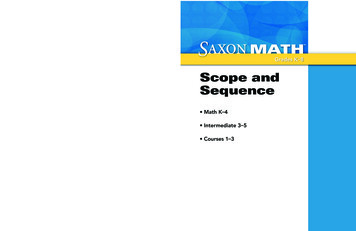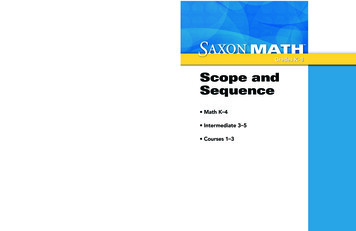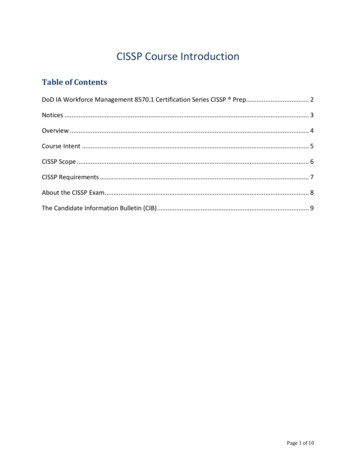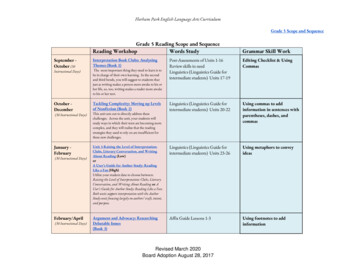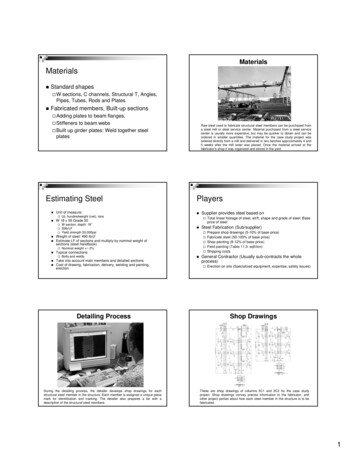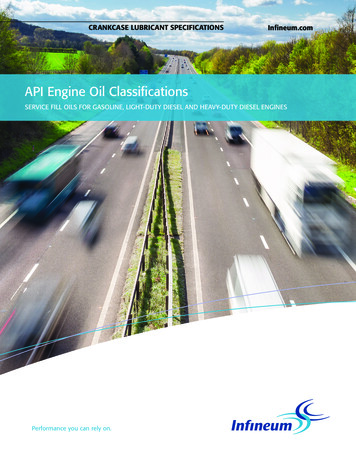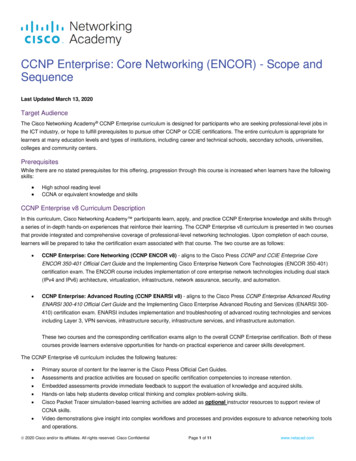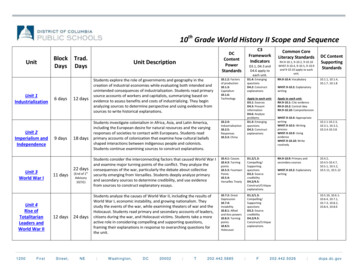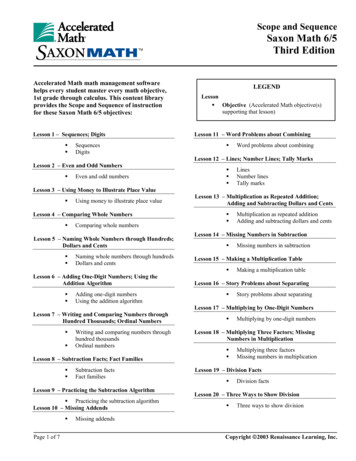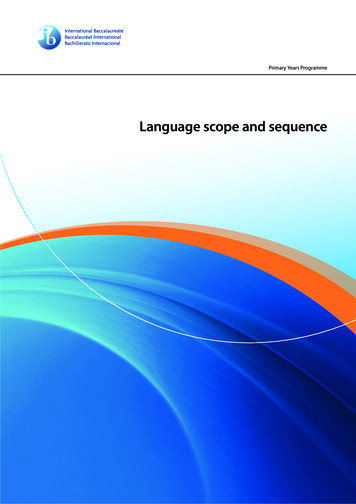
Transcription
Primary Years ProgrammeLanguage scope and sequence
Primary Years ProgrammeLanguage scope and sequence
Primary Years ProgrammeLanguage scope and sequencePublished February 2009International BaccalaureatePeterson House, Malthouse Avenue, Cardiff GateCardiff, Wales GB CF23 8GLUnited KingdomPhone: 44 29 2054 7777Fax: 44 29 2054 7778Website: http://www.ibo.org International Baccalaureate Organization 2009The International Baccalaureate (IB) offers three high quality and challengingeducational programmes for a worldwide community of schools, aiming to createa better, more peaceful world.The IB is grateful for permission to reproduce and/or translate any copyrightmaterial used in this publication. Acknowledgments are included, whereappropriate, and, if notified, the IB will be pleased to rectify any errors or omissionsat the earliest opportunity.All rights reserved. No part of this publication may be reproduced, stored in aretrieval system, or transmitted, in any form or by any means, without the priorwritten permission of the IB, or as expressly permitted by law or by the IB’s ownrules and policy. See http://www.ibo.org/copyright.IB merchandise and publications can be purchased through the IB store athttp://store.ibo.org. General ordering queries should be directed to the sales andmarketing department in Cardiff.Phone: 44 29 2054 7746Fax: 44 29 2054 7779Email: sales@ibo.orgPrinted in the United Kingdom by Antony Rowe Ltd, Chippenham, WiltshirePYP107
IB mission statementThe International Baccalaureate aims to develop inquiring, knowledgeable and caring young people who help tocreate a better and more peaceful world through intercultural understanding and respect.To this end the organization works with schools, governments and international organizations to developchallenging programmes of international education and rigorous assessment.These programmes encourage students across the world to become active, compassionate and lifelong learnerswho understand that other people, with their differences, can also be right.IB learner profileThe aim of all IB programmes is to develop internationally minded people who, recognizing their commonhumanity and shared guardianship of the planet, help to create a better and more peaceful world.IB learners strive to be:InquirersThey develop their natural curiosity. They acquire the skills necessary to conduct inquiryand research and show independence in learning. They actively enjoy learning and thislove of learning will be sustained throughout their lives.KnowledgeableThey explore concepts, ideas and issues that have local and global significance. In sodoing, they acquire in-depth knowledge and develop understanding across a broad andbalanced range of disciplines.ThinkersThey exercise initiative in applying thinking skills critically and creatively to recognizeand approach complex problems, and make reasoned, ethical decisions.CommunicatorsThey understand and express ideas and information confidently and creatively in morethan one language and in a variety of modes of communication. They work effectivelyand willingly in collaboration with others.PrincipledThey act with integrity and honesty, with a strong sense of fairness, justice and respectfor the dignity of the individual, groups and communities. They take responsibility fortheir own actions and the consequences that accompany them.Open-mindedThey understand and appreciate their own cultures and personal histories, and are opento the perspectives, values and traditions of other individuals and communities. They areaccustomed to seeking and evaluating a range of points of view, and are willing to growfrom the experience.CaringThey show empathy, compassion and respect towards the needs and feelings of others.They have a personal commitment to service, and act to make a positive difference to thelives of others and to the environment.Risk-takersThey approach unfamiliar situations and uncertainty with courage and forethought,and have the independence of spirit to explore new roles, ideas and strategies. They arebrave and articulate in defending their beliefs.BalancedThey understand the importance of intellectual, physical and emotional balance toachieve personal well-being for themselves and others.ReflectiveThey give thoughtful consideration to their own learning and experience. They are ableto assess and understand their strengths and limitations in order to support their learningand personal development. International Baccalaureate Organization 2007
ContentsIntroduction to the PYP language scope and sequence1What the PYP believes about learning language1Language in a transdisciplinary programme2The structure of the PYP language scope and sequence3How to use the PYP language scope and sequence5Language planning: Sample processes6Learning continuums8Oral language—listening and speaking8Visual language—viewing and presenting11Written language—reading15Written language—writing19References23Samples24Language scope and sequence
Introduction to the PYP language scope and sequenceThe information in this scope and sequence document should be read in conjunction with the languagesubject annex in Making the PYP happen: A curriculum framework for international primary education (2007).What the PYP believes about learning languageThe need to communicate is instinctive. The development of language is fundamental to that need tocommunicate; it supports and enhances our thinking and understanding. Language permeates the world inwhich we live; it is socially constructed and dependent on the number and nature of our social interactionsand relationships.The learning process simultaneously involves learning language—as learners listen to and use languagewith others in their everyday lives; learning about language—as learners grow in their understanding ofhow language works; and learning through language—as learners use language as a tool to listen, think,discuss and reflect on information, ideas and issues (Halliday 1980). An appreciation of these aspects oflanguage learning may help teachers better understand and enhance students’ learning. However, thesethree aspects are so inextricably linked they are best not thought of as discrete processes.Language plays a vital role in the construction of meaning. It empowers the learner and provides anintellectual framework to support conceptual development and critical thinking. In the IB Primary YearsProgramme (PYP), it is recognized that the teaching of language should be in response to the previousexperience, needs and interests of the student, rather than the consequence of a predetermined, prescriptivemodel for delivering language. Fragmenting learning into the acquisition of isolated skill sets can createdifficulties for learners—for example, learners may be able to read, write and spell words correctly inisolation but may not be able to read, write or spell those same words in other contexts. Learners’ needs arebest served when they have opportunities to engage in learning within meaningful contexts, rather thanbeing presented with the learning of language as an incremental series of skills to be acquired.The language profiles of students in PYP schools may be complex and diverse; however, the influence ofmother-tongue development is significant for all learners. It is acknowledged that development of mothertongue language is crucial for cognitive development, and in maintaining cultural identity. Success inmother-tongue development is a strong predictor of long-term academic achievement, including acquisitionof other languages.The complex processes involved in language learning represent a series of developmental continuums. Ateacher is able to identify where on those continuums a student is positioned to better design appropriate,contextualized learning experiences—to move the student from one development phase to the next. Inthis way, the learner is able to build on established skills and understanding, while being supported to meetappropriate challenges to extend their learning within their “zone of proximal development” (Vygotsky 1999),which may be represented by more than one phase.In PYP schools all students have the opportunity to learn more than one language from at least the ageof 7. Every learner benefits from having access to different languages, and, through that access, to differentcultures and perspectives. Acquisition of more than one language enriches personal development andhelps facilitate international-mindedness. For these reasons it could be argued that bilingualism, if notmultilingualism, is the hallmark of a truly internationally minded person and that this requirement shouldbe central to all three IB programmes. However, to accept this premise one would have to argue in supportof the reciprocal position, that a monolingual person has a limited capacity to be internationally minded.Language scope and sequence1
Introduction to the PYP language scope and sequenceThis is not the position the PYP has chosen to adopt. As well as the learning of an additional language, theother elements of the PYP framework that contribute to international-mindedness are described in Makingthe PYP happen: A curriculum framework for international primary education (2007). Most IB World Schoolsimplementing the PYP, particularly state or national system primary schools, would struggle to create alearning community where bilingualism was a realistic goal—indeed, it would be an impossibility in mostcases. Consequently, the strategic goal of the IB to broaden access to its programmes would be in conflictwith the notion of IB World Schools having bilingualism as a goal for all of their students.Effective language teaching and learning are social acts, dependent on relationships with others, withcontext, with the environment, with the world, and with the self. Such learning is relevant, engaging,challenging and significant. Exposure to and experience with languages, with all their richness and diversity,creates an inquisitiveness about life and learning, and a confidence about creating new social interactions.Language provides a vehicle for learners to engage with the world and, in an IB World School, to relate to,and accept, responsibility for the mission of the IB to “help to create a better and more peaceful world”.Language in a transdisciplinary programmeLanguage is involved in all learning that goes on in a school, in both the affective and effective domains.Learners listen, talk, read and write their way to negotiating new meanings and understanding newconcepts. In the “knowledge” area of the PYP, language is the most significant connecting element acrossthe school’s curriculum, both within and outside its transdisciplinary programme of inquiry. It is the school’sresponsibility to provide authentic contexts for language teaching and learning in all areas of the curriculumthat are a reflection of, and relevant to, the community of learners, and to the educational theoriesunderpinning the programme. In PYP schools there should be opportunities for students to negotiate theirroles. Literacy, including oral and visual literacy as well as the ability to read and write, becomes increasinglyimportant as greater demands are placed on learners as participants in the learning process.Language provides a vehicle for inquiry. In an inquiry-based classroom, teachers and students enjoy usinglanguage, appreciating it both functionally and aesthetically. The love and enjoyment of language throughthe integration of literature into student inquiry is an indicator of good practice in a PYP classroom. Forexample, this may include: a series of books read as an author study; regional fairy tales as part of a unitof inquiry with a particular social studies emphasis; discussing a scientist’s biography or a newspaperarticle to front-load a science investigation; early years counting stories as reinforcement for mathematicsdevelopment; and the comparison and practice of illustration techniques to encourage the development ofart skills.The programme of inquiry provides an authentic context for learners to develop and use language. Whereverpossible, language should be taught through the relevant, authentic context of the units of inquiry. Theteacher should provide language learning opportunities that support learners’ inquiries and the sharing oftheir learning. Regardless of whether language is being taught within or outside the programme of inquiry,it is believed that purposeful inquiry is the way in which learners learn best. The starting point should alwaysbe learners’ prior experience and current understanding.When teachers plan learning experiences that enable learners to develop language within meaningfuland enjoyable contexts, learners are able to make connections, apply their learning, and transfer theirconceptual understanding to new situations. This progressive conceptual development, together with anenjoyment of the process, provides the foundation for lifelong learning.2Language scope and sequence
Introduction to the PYP language scope and sequenceThe structure of the PYP language scope andsequenceThe complexity and diversity of language provision, and the range of individual language profiles that arerepresented in PYP schools throughout the world, present a unique challenge. Some of the variables thatexist in PYP schools include students learning in: a programme with one dominant language of instruction, which may be the students’ mother tongueor an additional language for them a bilingual programme where, most often, one of the languages of instruction is the student’s mothertongue a programme that offers support for students who are new to the language(s) of instruction; andadditional mother-tongue support.You may note that in PYP curriculum documents there is a reluctance to refer to “second language learning”and “second language learners” even though “second language” is a recognized linguistic term. Becauseit has several overlapping meanings, a decision was made over ten years ago by the PYP committee of theIB that the term “second language” could be misinterpreted and therefore misrepresent and oversimplifythe experiences of some students. It is in recognition of the complexity of language learning situations inIB World Schools that the preferred PYP term is a learner of “an additional language”.Some of the factors that will influence language development include similarities among language groups,exposure to the language, aptitude for the language, maturity, motivation, and both teaching and learningstyles. The rate of language development varies from one learner to another, and on the significance ofthe language being learned to the learner. In all language learning situations it is necessary to identify thelearner’s current developmental phase in order to plan learning experiences that will build on existingcapability and understanding so as to support the learner’s progression onto the next developmentalphase.Acknowledging that learning language is a developmental process, the scope and sequence documentpresents a set of developmental continuums that are designed as diagnostic tools to assist teachers inplanning language learning experiences for students, and in monitoring students’ development throughoutthe primary years. Consideration of the range of language learning situations that exist in PYP schools isreflected in this document. It is intended to inform and support all teachers, as all teachers are teachers oflanguage.In previous PYP language documents, progressive stages were organized into age groups. Thiscompartmentalization of learning does not recognize the real developmental aspects and fluid natureof language learning; nor does it recognize the compression and expansion of learning according to theprevious experience of the learner. Recognizing that learners in PYP schools enter the programme at differentages and with varying levels of language experience, it was decided that a sequence of developmentalphases would enable teachers to more accurately identify current levels of a student’s development andplan learning experiences leading onto subsequent phases.The strands of written, oral and visual language have been described separately, and are representedby four continuums: listening and speaking; viewing and presenting; reading; writing. Each strand issummarized through a list of overall expectations—generic statements that encapsulate the expectedlearning in a broad sense.The four language continuums in this document have been organized into five developmental phases witheach phase building upon and complementing the previous one. These phases have not been named inorder to avoid the value judgment implied in labelling a learner as “developing” or “proficient”, for example.The continuums make explicit the conceptual understandings that need to be developed at each phase.Language scope and sequence3
Introduction to the PYP language scope and sequenceEvidence of these understandings is described in the behaviours or learning outcomes associated witheach phase. For example, a 9 year old with well-developed mother-tongue ability may quickly showevidence of some—but not all—of the learning outcomes identified in the early phases when moving intoa new language of instruction; a child beginning school at age 3 may spend several years consolidatingunderstanding to demonstrate consistently the learning outcomes identified in the initial phase.Bearing in mind the range of individual differences and the diversity of language learning experiences,learners are likely to display understanding and skills from more than one of the developmental phases ata time. Consequently, it is recognized that teachers will interpret this scope and sequence according to theneeds of their students and their particular teaching situations.Some learners may enter the programme already demonstrating all of the outcomes in phase 1, whileothers may not demonstrate all of the outcomes in phase 5 by the end of their PYP years. However, theidentification of possible learning outcomes across five phases allows teachers to plan learning experiencesthat are challenging, rigorous and relevant to each student’s knowledge, understanding and skills, accordingto their previous experience, individual starting points and diverse ways of learning. It is also understoodthat the process of learning and development does not progress from one phase to another solely in onedirection, but that the learning is often more iterative.All three of the language strands are learned across and throughout the curriculum, and each strand isan integral component of language learning. Each strand has been considered from both the receptiveaspect—receiving and constructing meaning, and expressive aspect—creating and sharing meaning(figure 1). While the receptive and expressive aspects are clearly reciprocal, the processes involved inreceiving and constructing meaning are different from those involved in creating and sharing meaning.The learner’s ability to understand language and use it effectively varies in different situations and from oneindividual to another. For this reason, it is important to distinguish between these two modes of learningand the demonstrated proficiencies associated with them. For example, a learner may listen attentively andreveal understanding through written or visual representations, but may require support to communicateideas orally in the classroom.The acknowledgment of both the receptive and expressive aspects of the language strands serves toensure that teachers will be aware of the need to provide a balanced programme. Opportunities to listento, and receive, ideas and information in oral form should be balanced with opportunities to express ideasorally. In visual language, learners will view and interpret other people’s work and create and share theirown presentations. The interwoven receptive and expressive aspects of the oral and visual strands arerepresented in one continuum for each strand. In written language, learners will experience reciprocal gainsas they develop skills and understanding in reading and writing. Separate continuums have been developedfor reading and writing aspects of the written language strand.StrandReceptive—receiving andconstructing meaningExpressive—creating andsharing meaningOral languageListeningSpeakingVisual languageViewingPresentingWritten languageReadingWritingFigure 1Receptive and expressive aspects of language strands4Language scope and sequence
Introduction to the PYP language scope and sequenceHow to use the PYP language scope and sequenceThis language scope and sequence should be used in the context of a transdisciplinary, inquiry-basedprogramme. It does not stand alone, but complements: the annex entitled “Language in the Primary Years Programme” in Making the PYP happen: A curriculumframework for international primary education (2007) Guidelines for developing a school language policy (2008) Learning in a language other than mother tongue in IB programmes (2008).The language scope and sequence is structured around broad, transferable ideas—conceptualunderstandings—that all learners need to understand to become confident, creative and effectivecommunicators. The document has been generalized to apply to as many language groups and languagelearning situations as possible. It does not, therefore, include specific elements of a particular language orsituation.In the process of producing their written curriculum, schools may decide to use and adapt the PYP scopeand sequences according to their needs. For example, schools may decide to: incorporate the developmental continuums of the PYP scope and sequence into their existing schooldocuments frame their language scope and sequence document around the conceptual understandings outlinedin the PYP document, but develop another aspect, such as the learning outcomes, differently integrate additional external requirements, for example, indicators, benchmarks and standards, intothe PYP scope and sequence document.Schools need to be mindful of practice C1.23 in the IB Programme standards and practices (2005) that states“If the school adapts, or develops, its own scope and sequence documents for each PYP subject area, thelevel of overall expectation regarding student achievement expressed in these documents at least matchesthat expressed in the PYP scope and sequence documents.” To arrive at such a judgment, and given thatthe overall expectations in the PYP language scope and sequence are presented as broad generalities, it isrecommended that the entire document be read and considered.The continuums make explicit the conceptual understandings that need to be developed at each phase.The development of these understandings is supported by the learning outcomes associated with eachphase of each strand. The learning outcomes are written as observable behaviours or actions that willindicate to teachers how learners are constructing, creating and sharing meaning through language. Thelearning outcomes provide teachers with a way of looking at what learners can actually do and where theymay progress to next. They are, therefore, both diagnostic tools and a means of informing planning forfurther development. The overall expectations provide teachers with a narrative summary of the learningoutcomes at each phase. In summary, each group of linked overall expectations, conceptual understandingsand learning outcomes is called a “phase”; five phases represent the developmental continuum(s) of eachstrand.The continuums do not, however, provide evaluative criteria through which every learner is expectedto progress in sequential order. They reflect a developmental view of learning and are clearly related tothe contexts in which learning is taking place. Language development is not seen as a series of definedincremental steps through which all learners will progress in the same way.Language scope and sequence5
Introduction to the PYP language scope and sequenceThe following points should be considered when using the continuums to inform planning, teaching andassessing. The phases attempt to describe the language learning processes through which learners progress. It is acknowledged that there are earlier and later phases that have not been described in thesecontinuums. Learners within the same age group will have different proficiency levels and needs—thereforeteachers should consider a range of phases when planning language learning experiences for a classof learners. Each learner is a unique individual with different experiences and perceptions, so no two learnersprogress at the same rate, or along the same developmental pathways. A learner may exhibit a range of learning outcomes from various phases at any one time. Learners seldom progress in a neat and predictable manner; instead they may remain in one phase forsome length of time and move rapidly through other phases. The PYP language continuums are not prescriptive tools that assume a learner must attain all theoutcomes of a particular phase before moving on to the next phase, nor that the learner should be inthe same phase for each strand, or in the same phase for each language he or she is learning at anyone time.When using the continuums regularly, patterns will emerge for learners, indicating strengths and needs. Theteacher should be looking for evidence of what learning outcomes the student consistently demonstrates.An analysis of the demonstrated learning outcomes of each student will help the teacher decide when toconsolidate, reinforce or extend the learning. For example, if a student is in phase 3 for “oral language” butonly in phase 1 for “writing”, he or she may need additional support with the written language aspect oflanguage learning.The use of the PYP language continuums will be an encouragement for teachers to plan for differentiatedinstruction in the classroom. Providing appropriate learning experiences, as indicated by the assessment ofwhich phase a learner is in, will support each learner to make progress through the phases of development.6Language scope and sequence
Introduction to the PYP language scope and sequenceLanguage planning: Sample processesWhen planning for language learning experiences, be mindful of the following practices. Structured, purposeful inquiry is the main approach to teaching and learning language in the PYP. Wherever possible, language should be taught through the relevant and authentic context of thetransdisciplinary programme of inquiry.Within a unit of inquiryOutside the units of inquiryIt is important that the integrity of a centralidea and ensuing unit is not jeopardizedby a subject-specific focus too early in theplanning process. Once an inquiry has beenplanned through to the identification oflearning experiences, it would be appropriateto consider the following process.When specific aspects of language learningneed to be addressed outside the units ofinquiry, purposeful inquiry is still consideredthe principal way in which students learn best.Identify which conceptualunderstanding(s) (from the languagecontinuums) students have already shownevidence of.Considering the central idea, thesummative assessment task(s), andthe learning experiences of the unitof inquiry, identify which conceptualunderstanding(s) (from the languagecontinuums) will support and inform learningin the unit of inquiry.Identify learning outcomes (listed in thelanguage scope and sequence continuums)that will provide evidence of each student’slanguage development while contributing toengagement with the unit of inquiry.Decide what differentiation will be requiredin order to appropriately use and developlanguage for each student during the unit.Decide whether all the language learningexperiences will occur within the unit ofinquiry or whether some subject-specificfront-loading experience is required, prior toapplication within the unit of the inquiry.To build on what students already understandand can do, identify the conceptualunderstanding(s) that will provide eitherreinforcement or an appropriate level ofchallenge for the next stage of learning.Identify the demonstrated learningoutcomes (listed in the language scopeand sequence continuums) that shouldprovide observable evidence of whether theconceptual understanding(s) have beenachieved, and whether the students havebeen able to apply their understanding indiverse ways.Plan a range of learning experiencesthat accommodate the appropriatedevelopmental phases of all learners, andwill enable individual learners to consolidateand develop understanding, demonstrateskills and knowledge and move on to newchallenges.Ensure that assessment will inform eachstudent’s language profile and furtherlearning needs.Figure 2Sample processes when planning for language learning experiencesLanguage scope and sequence7
Learning continuumsOral language—listening and speakingListening and speaking are natural, developmental processes that infants and young children are immersedin from their earliest experiences. Almost all children arrive at school with an impressive command of theirmother-tongue language. However, the expectations and approach to language development in school isoften very different from the successful learning environment the child has previously experienced. In thetransition from home to school, or from one school to another, it is important to acknowledge the languageprofile of the individual and build on previous learning in ways that are positive and productive.Oral language encompasses all aspects of listening and speaking—skills that are essential for ongoinglanguage development, for learning and for relating to others. Listening (the receptive mode) and speaking(the expressive mode) work together in a transactional process between listeners and speakers. A balancedprogramme will
how language works; and learning through language—as learners use language as a tool to listen, think, discuss and reflect on information, ideas and issues (Halliday 1980). An appreciation of these aspects of language learning may help teachers better understand and enhance students' learning. However, these
